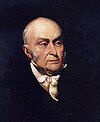Samuel L. Southard
Samuel Lewis Southard | |
|---|---|
Peter Dumont Vroom | |
| Succeeded by | Elias P. Seeley |
| 7th United States Secretary of the Navy | |
| In office September 16, 1823 – March 4, 1829 | |
| President | James Monroe John Quincy Adams |
| Preceded by | Smith Thompson |
| Succeeded by | John Branch |
| Personal details | |
| Born | Samuel Lewis Southard June 9, 1787 Basking Ridge, New Jersey, U.S. |
| Died | June 26, 1842 (aged 55) Fredericksburg, Virginia, U.S. |
| Resting place | Congressional Cemetery |
| Political party | Democratic-Republican (Before 1825) National Republican (1825–1834) Whig (1834–1842) |
| Spouse | Rebecca Harrow |
| Education | Princeton University (BA) |
| Signature | |
Samuel Lewis Southard (June 9, 1787 – June 26, 1842) was a prominent American statesman of the early 19th century, serving as a
History
The son of Henry Southard and Sarah (Lewis) Southard, Henry was born in the Basking Ridge section of Bernards Township, New Jersey, on June 9, 1787.[1] Southard's ancestors included Anthony Janszoon van Salee, one of the earliest settlers of New Amsterdam, and his siblings included Isaac Southard.[2][3] Southard attended the Brick Academy[4] classical school and graduated from Princeton University in 1804.[1]
Early career
After teaching in New Jersey, he worked for several years as a tutor in the
President
Political life
In 1829 Southard became New Jersey Attorney General, succeeding Theodore Frelinghuysen.[1] In 1832, the state legislature elected him Governor over Peter D. Vroom by a vote of 40 to 24. In 1833, he was again elected to the U.S. Senate. During the next decade, he was a leader of the Whig Party and attained national prominence as chairman of the Committee on Naval Affairs. As President pro tempore of the Senate, he was first in the presidential line of succession after the death of William Henry Harrison and the accession of Vice President John Tyler to the presidency.
Failing health forced Southard to resign from the Senate in 1842. He died in Fredericksburg, Virginia, on June 26, 1842.[6] Southard was buried in Washington's Congressional Cemetery.
Societies
During the 1820s, Southard was a member of the prestigious society, Columbian Institute for the Promotion of Arts and Sciences, who counted among their members former presidents Andrew Jackson and John Quincy Adams and many prominent men of the day, including well-known representatives of the military, government service, medical and other professions.[7] In 1839, he was elected to the American Philosophical Society.[8]
Legacy
The destroyer USS Southard (DD-207), (later DMS-10), 1919–1946, was named in his honor. There is also a public park in Basking Ridge, New Jersey, named after him. There is also a street named after him in Key West, FL as well as Southard Street in Trenton, New Jersey.[9]
See also
References
- ^ ISBN 978-1-8785-9244-6 – via Google Books.
- ^ De Halve Maen. Vol. 63–68. New York, NY: The Holland Society of New York. 1990. p. 4 – via Google Books.
- ISBN 978-1-4522-3532-5 – via Google Books.
- ISBN 978-0-8135-3325-4 – via Google Books.
- ISBN 978-0-8386-3160-7.
- ^ "Death of Samuel L. Southard". Alexandria Gazette. June 28, 1842. p. 3. Retrieved July 2, 2023 – via Newspapers.com.
- ^ Rathbun, Richard (1904). The Columbian institute for the promotion of arts and sciences: A Washington Society of 1816-1838. Bulletin of the United States National Museum, October 18, 1917. Retrieved June 20, 2010.
- ^ "APS Member History". search.amphilsoc.org. Retrieved April 9, 2021.
- ^ https://www.trentonhistory.org/streets.html
Sources
 This article incorporates public domain material from websites or documents of the Naval History and Heritage Command.
This article incorporates public domain material from websites or documents of the Naval History and Heritage Command.- Dictionary of American Biography.
- Birkner, Michael. Samuel L. Southard: Jeffersonian Whig. Rutherford, N.J.: Fairleigh Dickinson University Press, 1984.
- Ershkowitz, Herbert. Samuel L. Southard: A Case Study of Whig Leadership in the Age of Jackson. New Jersey History 88 (Spring 1970): 5-24.
- "Samuel L. Southard Papers (1783-1893),(bulk 1802-1846), Finding Aid C0250", consisting of 170 boxes and 73.6 lineal feet of original documents of financial and personal affairs, including correspondence from Charles Muir Campbell of Princeton, NJ. Most boxes are organized by year and subject. Access to these documents is via Princeton University Library, Department of Rare Books and Special Collections, Manuscripts Division.








